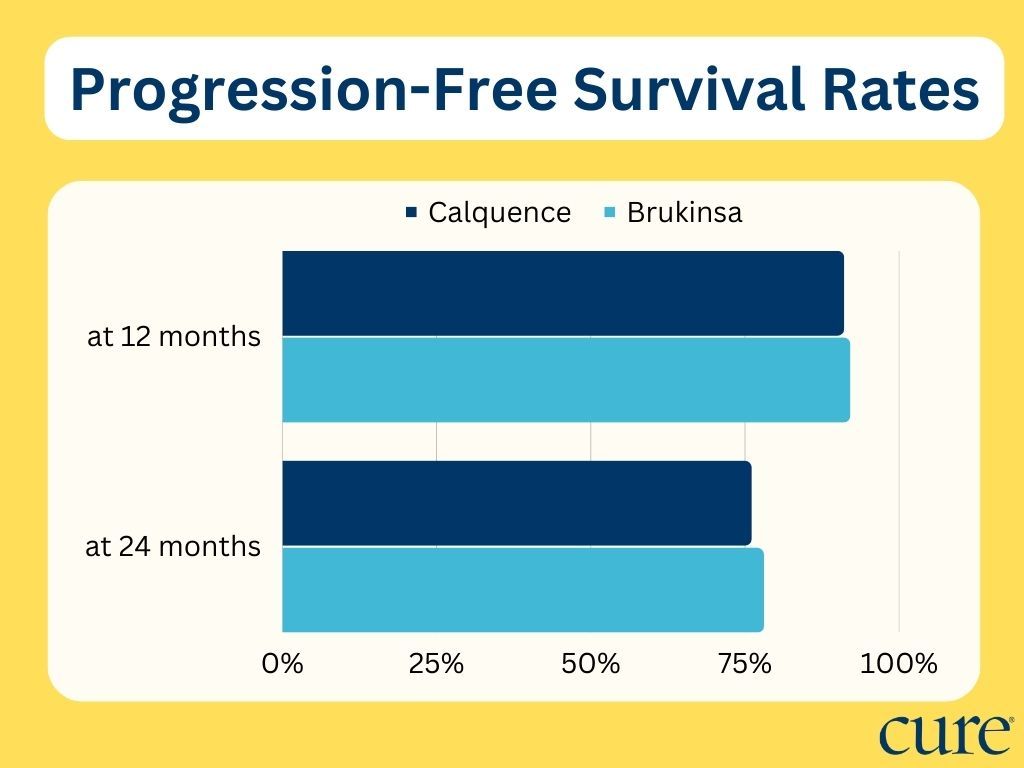News
Article
Calquence and Brukinsa Have Similar Relapsed/Refractory CLL Outcomes
Author(s):
There was no major difference in progression-free survival between patients with relapsed/refractory chronic lymphocytic leukemia who were treated with Calquence or Brukinsa.
Patients treated with Calquence (acalabrutinib) or Brukinsa (zanubrutinib) experienced similar lengths of time before their disease got worse, according to compared data of two phase 3 clinical trials, ASCEND and ALPINE.
Progression-free survival was similar between patients with relapsed/refractory chronic lymphocytic leukemia who were treated with Calquence of Brukinsa.

The primary efficacy analysis revealed similar progression-free survival — which is the time patients live after treatment without their disease getting worse — for Calquence (99 patients) and Brukinsa (327 patients). The 12-month progression-free survival rate for Calquence was 91% and 76% at 24 months. The 12-month progression-free survival rate for Brukinsa was 92% and 78% at 24 months. Finally, the 12-month progression-free survival rate for Imbruvica (ibrutinib; 325 patients) was 84% and 66% at 24 months.
Calquence and Brukinsa were compared with Imbruvica in patients with relapsed/refractory CLL in the phase 3 ELEVATE-RR and ALPINE trials, respectively. However, differences in enrollment prevent anchored indirect treatment comparisons between the second-generation agents. As such, investigators performed an indirect comparison of the safety and efficacy of Calquence versus Brukinsa with patient data from the ASCEND and ALPINE trials.
The ASCEND trial evaluated treatment with Calquence compared chemotherapy and the ALPINE trial evaluated Brukinsa versus Imbruvica, both in patients unrestricted by 17p or 11q deletions who had received one median prior line of therapy. The ELEVATE-RR trial evaluated Calquence against Imbruvica in patients with 17p and/or 11q deletions who had received a median of two prior lines of therapy.
Patient data was matched and compared based on variables including age, region of enrollment, sex, ECOG performance status (which shows how independently a person can perform their daily activities), bulky disease, prior chemoimmunotherapy, 17p or 11q deletions, TP53 mutations without 17p deletions, IGHV mutational status, number of prior lines of therapy and Rai stage.
Investigator-assessed progression-free survival was assessed in all randomized patients with complete baseline data before and after matching.
Additional results demonstrated that prior to matching, both the Brukinsa and Calquence populations were well balanced, except for region of enrollment. After matching, the effective sample size of the Calquence arm was 99, which represented 66% of the original efficacy sample. A total of 65% of these patients were male and had a median age of 66 years. Notably, there we no differences between matched variables and differences between non-matched variables were reduced.
Following matching in the secondary analysis, Calquence demonstrated superior investigator-assessed progression-free survival to Imbruvica. Moreover, in the sensitivity analysis, which reduced the effective sample size with Calquence to 33% of the original pooled arm, no differences were reported in investigator-assessed progression-free survival between the pooled Calquence and Brukinsa arms.
Overall, matching had little impact on the safety results of Calquence, and the safety profiles seen with Brukinsa and Calquence were similar, with some exceptions. This included the risk of a serious side effect, any-grade hypertension, grade 3 or higher hypertension, any grade hemorrhage or a side effect leading to dose reduction, all of which occurred more often in patients treated with Brukinsa versus Calquence. Notably, pre-matching, lower cumulative incidence rates of any grade hypertension were seen in the Calquence vs Brukinsa arm.
The study authors acknowledged that limitations from the matching-adjusted indirect comparison mean the results should be viewed as hypothesis generating.
Editors Note: This article was updated on August 17, 2023.
For more news on cancer updates, research and education, don’t forget to subscribe to CURE®’s newsletters here.




